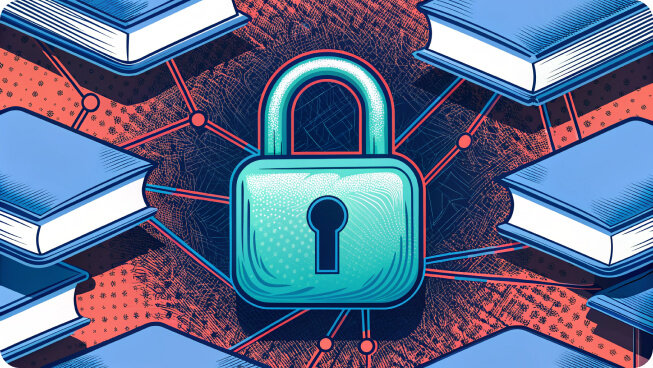Online learning platforms enable schools, universities, and individual course creators to connect with students from anywhere in the world. This can introduce flexibility and opportunity, but also introduces new risks. Every login, every upload of an assignment, every chat message generates data that can be sensitive and identifiable. If that data is abused, compromised, or leaked, it can harm both learners and educators alike.
Being privacy-oriented is more than a legal obligation; it is a commitment of trust. Students and parents want to have confidence that their personal information, including competencies, progress, and payment details, will be kept private.
In this article, we will outline a straightforward and practical set of steps to protect student data.
What Counts as Student Data? Scope and Sensitivity
Before you can protect student data, you must first know what it refers to. Many educators believe student data is only names and email addresses, but it is much broader than that. Online learning platforms collect and process a wide range of information, each with varying degrees of sensitivity.

Data on students that is typically managed online includes:
-
Personal identifiers (names, date of birth, phone numbers, addresses)
-
Account credentials (usernames, passwords, recovery email addresses, and tokens)
-
Academic records (grades, assignments, assignment comments or feedback, certificates)
-
Payment data (credit card information, transaction history, receipts)
-
Behavioral data (progress through a course, activity logs, and time in a session)
-
Communications (posts in forums, private messages, and comments from teachers)
Not all data poses the same level of risk if it were to leak. A post in a discussion forum is likely not as sensitive as financial data, but even casual communications can reveal identity or a private struggle in the wrong context.
A helpful way to think about data is tiers of sensitivity:
-
Public Data (course catalog, contributions to a public forum)
-
Internal Data (attendance, grades visible only by staff)
-
Confidential Data (financial data, medical notes, personal student identification).
When savvy educators and administrators understand these variations, they can apply stronger security to what matters most.
Common Risks in Online Learning
When operating an online learning platform, you create risks around student data that are likely not the work of skilled hackers, but rather the result of people making trivial mistakes.
The common risks are:
-
Phishing: For example, fake login pages or emails trick users into sharing passwords.
-
Weak/reused passwords: Mavericks logging in with basic passwords (for example, “123456”) or reusing passwords are making it easy for someone to target their account.
-
Links shared too broadly: Although course material links might be open, this data can be accessible to anyone with the link.
-
Misconfigured permissions: Granting “admin” access to everyone freely could lead to unnecessary access to your learning platforms.
-
Unvetted plug-ins: Third-party applications could create back doors to access student data.
-
Shadow IT: Allowing students to use unsanctioned tools (e.g., free file-sharing sites for their projects) means they are factoring security out of the equation.
Example: A student sets a link to a shared drive to “anyone with the link.” The link gets circulated beyond the class and exposes private work and comments.

Laws and Standards You Should Know
Protecting student data is not only smart, but also a legal obligation for all governments. All governments have rules in place to safeguard personal information, and online learning platforms must comply with these regulations, especially when working with international students.
The GDPR is one of the most stringent laws that exists, which mandates the following:
-
Legitimate basis to process personal data.
-
Only collect information that is required.
-
Recognize students' rights to access, modify, obliterate, or request to have personal data exported.
-
Conduct Data Protection Impact Assessments (DPIAs) for processing personal data deemed sensitive.
However, there are other important standards, such as CCPA/CPRA (California), FERPA & COPPA (USA), PIPEDA (Canada), and ISO/IEC 27001.
Why does this matter? We live in a global education environment. If you are teaching students from the EU, then the GDPR applies to your organization, even when you are located well outside of Europe (and within Canada). Platforms like Kwiga help educators demonstrate compliance with GDPR and other important standards, so instructors can fulfill these obligations without needing a law firm.
Choosing a Privacy-Centric Platform
Your chosen platform serves as the foundation for protecting student information. Strong policies can't overcome poor technology, so it's paramount that you pick a privacy-oriented product.
When shopping between platforms, consider:
-
Data residency options: Options for keeping information in jurisdictions that align with your compliance requirements.
-
Strong encryption: Secure transmission (TLS) and storage (AES-256 or above).
-
Granular access control: RBAC permissions ensure that only authorized individuals view sensitive records.
-
Audit records: Record what was accessed by whom, when, and where.
-
Fast export and delete tools: These allow you to respond to student requests quickly.
-
Security for authentication: Single sign-on (SSO), multi-factor authentication (MFA).
-
API governance: Ensuring integrations don't leak sensitive information.
-
Data Processing Agreement (DPA): A document recording compliance obligations by the provider.
Kwiga is GDPR- and other international standard-compliant, with course controls for access and role-specific permission for students, assistants, and admins. It also includes secure payment handling, as well as edit/delete/export tools for managing student information.
Access Control That Actually Works
Just because a site is very safe in its location doesn't make student information safe if access is not properly governed. There is only one rule you should live by: least privilege — grant each user only what they need access to, not a whit more.
Role-Based Access
Establish clear roles, such as administrator, teacher, helper, and learner. There ought to be limitations for every role:
-
Students can only view their own records.
-
They are allowed to note but not view financial information.
-
Administrators manage settings but should not casually enter student chat logs.
Authentication and Session Security
You can choose among these approaches:
-
Single Sign-On (SSO): Allows easy login and reduces password fatigue.
-
Multi-Factor Authentication (MFA): Introduces a second factor, which renders stolen passwords less threatening.
-
Session timeouts: Automatically log users out after a specified period of inactivity to prevent unauthorized access.
Periodic Access Reviews
Permissions should not remain constant. Leavers or staff members whose tasks are completed should have their access disabled immediately. Conduct quarterly access audits to identify outdated or excessive permissions.
Tip: Promote the use of strong passwords or passphrases, and whenever possible, distribute hardware security keys to administrators. These significantly lessen the risk of hijacked accounts.
Data Minimization and Retention
One of the easiest and most pragmatic ways to protect student information is to request less and retain it for a shorter period. The more you collect, the larger the target for bad actors — and the more difficult it is to stay in compliance with privacy regulations.
Collect Only What You Need
Ask yourself: “Do I absolutely need this piece of information to teach or assist my students?” For instance, you might require a student's email to send lessons, but not their entire home address.
Define Retention Periods
Every kind of data must have an explicit retention time:
-
Assignments and marks: Retain only for as long as is necessary for marking and appeals.
-
Messages and chat logs: Keep for a few months, then delete or archive.
-
Payment records: Retain as long as necessary to fulfill legal or tax reporting requirements, but not indefinitely.
Archiving vs. Deletion
There will be times when information needs to be saved for historical reasons or for accreditation purposes. For these events, save it with restricted access. For all other purposes, securely erase when no longer needed.
Encryption and Secure Transfer/Storage
Even with strict access controls and retention policies in place, data remains susceptible to compromise if it is not properly managed and stored as encrypted data.
Data in Transit
Whenever students log in to their accounts, submit assignments, or make payments, their data travels across the internet. Transport Layer Security (TLS) protects this type of information traveling over the internet, making it harder for an attacker to intercept it or obtain authentication tokens, such as usernames, passwords, and credit card numbers.

Data at Rest
Somewhere on a server on the Internet, the student file(s) are stored as encrypted data. Student records should require government-approved levels of encryption, strong enough to protect their personally identifiable information, using strong algorithms like AES-256. Using AES-256 means that even if someone manages to steal a database, the encrypted data will be unintelligible without access to the appropriate decryption keys.
Key Management
Encryption can only be as strong and reliable as it is managed. Keys must be stored securely and adequately, rotated, and protected from unauthorized access.
Backup and Restoration Testing
It is not enough to simply back up your data; you must also back up your data in an encrypted format. Backup testing also requires encrypted backups, or a corrupted or insecure backup can be just as catastrophic as a corrupted or insecure database.
Third-Party Apps, Cookies, and Consent
Online course sites can integrate third-party tools such as video tools or analytics boards. They enhance learning but may breach privacy.
Vetting Tools
Verify what student data the tool has access to, request that the vendor provide a Data Processing Agreement (DPA), and demand transparency regarding any sub-processors. Only accept tools that are compliance-ready.
Cookies and Tracking
Plates utilize cookies for login and performance. In the case of laws such as GDPR, students should be informed and regularly provide a positive opt-in. Banner notices and preference settings assist.
High-Risk Tools
Tools such as proctoring or biometric tools require additional protection. Perform a Data Protection Impact Assessment (DPIA) before their use.
Governance: Policies, Training, and Audits
When it comes to privacy, technology is simply not enough. To become ingrained in the culture and environment of the school or college, privacy requires clear policies, staff training, and audits to be fully established.
Policies
Keep policies short and practical. Use plain language to cover data collection, platform usage, password access, retention timelines, and other relevant details.
Staff Training
Teachers and administrators are the first line of defense. Provide staff with annual training on phishing, requests to have data removed under GDPR legislation, and safe use of third-party apps.
Audits
You need to test things and not assume they are working correctly. Undertake periodic audits of access rights to data, system logs, and adherence to data deletion conditions.
Metrics
Measure things like response times to data requests, number of failed logins, number of policies breached, etc.
Conclusion
Student data protection is no longer a nice-to-have but a requirement for all in schools and in education. Do privacy correctly so you not only stay GDPR- and other internationally compliant, but also protect what makes it possible for online learning to exist in the first place: student trust.
As an action step towards this, here is a 10-point checklist you can use today:
-
Map what student data you collect and why.
-
Utilize a GDPR-compliant platform, such as Kwiga, that aligns with international standards.
-
Use role-based access control and implement MFA.
-
Retrieve only the bare minimum of necessary information.
-
Establish efficient policies for retention and deletion of data.
-
Encrypt all data in transit (TLS) and stored at rest (AES-256).
-
Check third-party applications and ask for permission.
-
Provide an opt-in option for learners to uphold their right.
-
Develop an incident response plan and test it.
-
Continuously train workforce members and perform privacy audits.
It is not only about law, but also about trust, and only trust can create a thriving online educational scene.





